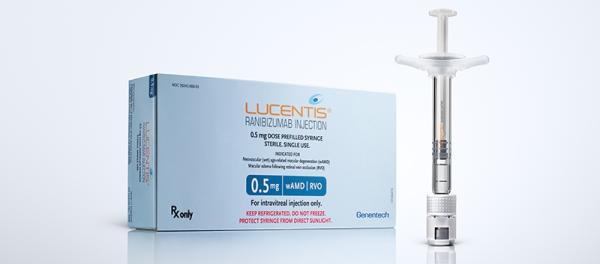Ranibizumab Ophthalmic Dosage
Medically reviewed by Drugs.com. Last updated on Oct 31, 2023.
Applies to the following strengths: 100 mg/mL; 10 mg/mL; 6 mg/mL; eqrn 6 mg/ml; eqrn 10 mg/ml; nuna 10 mg/mL
Usual Adult Dose for:
Additional dosage information:
Usual Adult Dose for Macular Degeneration
Maintenance dose: 0.5 mg intravitreally once a month (approximately 28 days)
Uses: Neovascular (Wet) Age-Related Macular Degeneration (AMD), Myopic Choroidal Neovascularization (mCNV)
Usual Adult Dose for Diabetic Retinopathy
- DME and Diabetic Retinopathy:
Uses: Diabetic macular edema (DME); Diabetic Retinopathy (DR)
- Macular Edema following RVO:
Use: Macular Edema Following Retinal Vein Occlusion (RVO)
Usual Adult Dose for Macular Edema
- DME and Diabetic Retinopathy:
Uses: Diabetic macular edema (DME); Diabetic Retinopathy (DR)
- Macular Edema following RVO:
Use: Macular Edema Following Retinal Vein Occlusion (RVO)
Renal Dose Adjustments
Data not available
Liver Dose Adjustments
Data not available.
Dose Adjustments
Although Not as Effective, the Following Dosing Regimens May Be Used in Patients with Neovascular (Wet) AMD:
- Administer 3 monthly doses followed by less frequent dosing with regular assessment. In the 9 months after 3 initial monthly doses, less frequent dosing with 4 to 5 doses on average is expected to maintain visual acuity while monthly dosing may be expected to result in an additional average 1 to 2 letter gain.
- Administer 1 dose every 3 months after 4 monthly doses with regular assessment. Compared with continued monthly dosing, dosing every 3 months over the next 9 months will lead to an approximate 5-letter (1-line) loss of visual acuity benefit on average.
Precautions
CONTRAINDICATIONS:
- Hypersensitivity to the active component or any of the ingredients
- Patients with ocular or periocular infections
Safety and efficacy have not been established in patients younger than 18 years.
Consult WARNINGS section for additional precautions.
Dialysis
Data not available.
Other Comments
Administration Advice:
- This drug is for ophthalmic intravitreal injection only.
- Each vial or prefilled syringe should only be used for treatment of a single eye; use of more than one injection can lead to contamination and subsequent infection.
- Adequate anesthesia and a broad-spectrum microbicide should be given prior to the injection.
Storage Requirements:
- This drug should be refrigerated at 2C to 8C (36F to 46F) protected from light and stored in its original carton until time of use. Do not freeze.
Preparation Techniques:
- The manufacturer product information should be consulted on proper drug preparation and injection procedure.
General:
- This drug is produced by an Escherichia coli expression system in a nutrient medium containing tetracycline; tetracycline is not detectable in the final product.
Monitoring:
- Intraocular pressure using tonometry (prior to and 30 minutes following injection)
- Perfusion of the optic nerve head (immediately after injection)
- Symptoms of endophthalmitis (following injection)
Patient Advice:
- Seek immediate care from an ophthalmologist if your eye becomes red, painful, sensitive to light, or develops a change in vision.
More about ranibizumab ophthalmic
- Check interactions
- Compare alternatives
- Reviews (19)
- Side effects
- During pregnancy
- Drug class: anti-angiogenic ophthalmic agents
- Breastfeeding
Patient resources
- Ranibizumab ophthalmic drug information
- Ranibizumab (Advanced Reading)
- Ranibizumab-eqrn (Advanced Reading)
- Ranibizumab
Other brands
Lucentis, Cimerli, Byooviz, Susvimo
Professional resources
Other brands
Lucentis, Cimerli, Byooviz, Susvimo
Related treatment guides
See also:
Further information
Always consult your healthcare provider to ensure the information displayed on this page applies to your personal circumstances.


